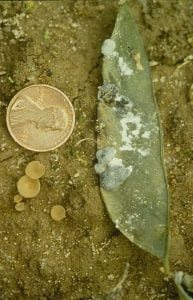Kate Everts, Vegetable Pathologist, University of Delaware and University of Maryland; keverts@umd.edu
Pythium Blight (Cottony Leak)
Pythium blight has been a problem on the Delmarva during periods of rainy weather and cool temperatures. The disease causes damage on several plant species, including beans. The presence of Pythium blight is obvious by the profuse mycelia on infected fruit or stems. To reduce the damage from Pythium blight, improve air movement in and around the plants. Also, applications of Prophyte, K-Phite, Phostrol or Rampart have been effective in recent trials. A Section 24c label is available in Maryland and Delaware for use of Ridomil Gold Copper.
White Mold
We are at risk of white mold on green beans that are near or at flowering. The spray guidelines are that if the soil has remained wet for 6 to 10 days in your field and the bean crop is at 10 to 20% bloom, a fungicide should be applied. A second spray should be made 7-10 days after the first spray if the soil remains wet and blossoms are still present. Check labels for details on fungicide timing. The following are effective on white mold: Endura, iprodione, Omega thiophanate-methyl (Topsin-M), Switch, or Switch plus thiophanate methyl].
Remember that there is a very effective biological alternative to fungicide sprays. Contans is an outstanding alternative for organic and conventional growers alike. Contans is a formulation of the fungus Coniothyrium minitans, which parasitizes the survival structures of the pathogen Sclerotinia sclerotiorum. In trials throughout the U.S. Contans has worked well at reducing white mold severity. The challenge with using Contans is that it should be applied two months before the disease develops. Contans is OMRI listed from SipCam Advan, LLC. Because the product is living, it must be handled carefully prior to use.
Signs of Sclerotinia sclerotiorum (apothecia and sclerotia) on the soil surface.

